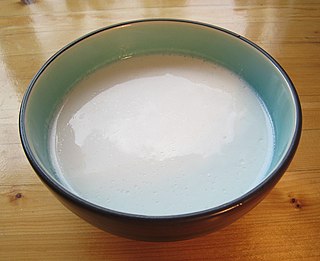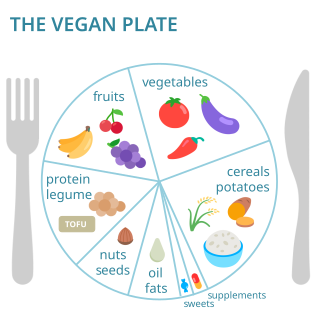
Virol, also stylised as ViRoL, was a British twentieth-century brand of malt extract preparation that also included bone marrow, and was designed as a nutritional supplement for the feeding of infants.

Virol, also stylised as ViRoL, was a British twentieth-century brand of malt extract preparation that also included bone marrow, and was designed as a nutritional supplement for the feeding of infants.
The original ingredients of Virol were red marrow extracted by the use of glycerol from the rib bones of cattle and the bones of calves, refined beef fat, diastatic malt (containing a mixture of amylases that convert starch into maltose and dextrin), eggs, lemon syrup and soluble phosphates. This emulsified product was rich in nutrients and the manufacturing process did not destroy the vitamin content. Later, orange juice replaced lemon juice. [1]
Virol was first made in 1899 as an experimental product by Bovril in their London factory in Old Street, and was designed as a nutritional supplement for the feeding of infants. A company was set up to manufacture it the following year. Demand grew, and by the 1920s, production was transferred to a larger, more modern factory in Perivale. Before World War II, the version "Virol and Milk" was established as a direct competitor to Horlicks. During the war, production ceased as the ingredients became too difficult or costly to acquire. After the war, production resumed and the brand changed hands several times with consolidation in the food processing industry, to Cavenham Foods in 1971, Janks Brothers in 1977, and Optrex in 1979. Virol was discontinued in the 1980s. [2] [3]

In 1929, the product was exhibited at the British Industries Fair.
Originally designed as a nutritional supplement for the feeding of infants, some children who grew up in the 1940s remember the weekly visit of the Virol Lady to their primary school, doling out spoonfuls of the sweet, sticky brown product to each child who had brought a penny to school for the purpose. [2]
Virol was initially supplied in ceramic jars of different sizes. By the 1950s it was marketed in brown glass jars as a health supplement. Alternative suggested usages were as a nerve tonic to treat depression and nervousness, for which purpose it was called "Virol and Milk", and as a laxative under the trade name "Virolax". [4]
The product was advertised on orange-navy-and-white, enamelled metal wall plaques as being of benefit to various groups; "Anaemic girls need it", "Growing boys need it", "School children need it", "Delicate children need it" and the more generic "For health and vitality". In an advertisement in Punch magazine in November 1950, an illustration of a boy giving a girl a piggyback was accompanied by the slogan "CHILDREN GROW STRONG ON VIROL. Virol is the food for growth. It provides these essential food factors – not vitamins alone, but also many others just as important – which are likely to be deficient in the rest of the diet. Give Virol after every meal. Children love the flavour of Virol and they thrive on it." [5]

Marmite ( MAR-myte) is a British savoury food spread based on yeast extract, invented by the German scientist Justus von Liebig. It is made from by-products of beer brewing (lees) and is produced by the British company Unilever. Marmite is a vegan source of B vitamins, including supplemental vitamin B12. A traditional method of use is to spread it very thinly on buttered toast.

Scurvy is a disease resulting from a lack of vitamin C. Early symptoms of deficiency include weakness, fatigue, and sore arms and legs. Without treatment, decreased red blood cells, gum disease, changes to hair, and bleeding from the skin may occur. As scurvy worsens, there can be poor wound healing, personality changes, and finally death from infection or bleeding.

Orange juice is a liquid extract of the orange tree fruit, produced by squeezing or reaming oranges. It comes in several different varieties, including blood orange, navel oranges, valencia orange, clementine, and tangerine. As well as variations in oranges used, some varieties include differing amounts of juice vesicles, known as "pulp" in American English, and "(juicy) bits" in British English. These vesicles contain the juice of the orange and can be left in or removed during the manufacturing process. How juicy these vesicles are depend upon many factors, such as species, variety, and season. In American English, the beverage name is often abbreviated as "OJ".

Infant formula, also called baby formula, simply formula, baby milk or infant milk, is designed and marketed for feeding to babies and infants under 12 months of age, usually prepared for bottle-feeding or cup-feeding from powder or liquid. The U.S. Federal Food, Drug, and Cosmetic Act (FFDCA) defines infant formula as "a food which purports to be or is represented for special dietary use solely as a food for infants by reason of its simulation of human milk or its suitability as a complete or partial substitute for human milk".

Horlicks is a British sweet malted milk hot drink powder developed by founders James and William Horlick. It was first sold as "Horlick's Infant and Invalids Food", soon adding "aged and travellers" to their label. In the early 20th century, it was sold as a powdered meal replacement drink mix.

Ovaltine is a brand of milk flavoring product made with malt extract, sugar, and whey. Some flavors also have cocoa. Ovaltine, a registered trademark of Associated British Foods, is made by Wander AG, a subsidiary of Twinings, which acquired the brand from Novartis in 2002, except in the United States, where Nestlé acquired the rights separately from Novartis in the late 2000s.

Baby food is any soft, easily consumed food other than breastmilk or infant formula that is made specifically for human babies between six months and two years old. The food comes in many varieties and flavors that are purchased ready-made from producers, or it may be table food eaten by the family that has been mashed or otherwise broken down.

Koninklijke DSM N.V., was a Dutch multinational corporation active in the fields of health, nutrition and materials. Headquartered in Heerlen, at the end of 2017 DSM employed 21,054 people in approximately 50 countries and posted net sales of €8.632 billion in 2018 and €9.204 billion in 2021. In May 2023 it merged with the Swiss company Firmenich to form a new entity named dsm-firmenich.

Milo is a chocolate-flavoured malted powder product produced by Nestlé, typically mixed with milk, hot water, or both, to produce a beverage. It was originally developed in Australia by Thomas Mayne (1901–1995) in 1934.

Therapeutic foods are foods designed for specific, usually nutritional, therapeutic purposes as a form of dietary supplement. The primary examples of therapeutic foods are used for emergency feeding of malnourished children or to supplement the diets of persons with special nutrition requirements, such as the elderly.

Maltesers are a British confectionery product manufactured by Mars Inc. First sold in the UK in 1937, they were originally aimed at women. They have since been sold in Europe, Australia, New Zealand, Canada, United States and Middle East. The slogan is "The lighter way to enjoy chocolate".

Plant milk is a non-dairy beverage made from a water-based plant extract for flavoring and aroma. Plant milks are consumed as alternatives to dairy milk, and may provide a creamy mouthfeel.

A milk substitute is any substance that resembles milk and can be used in the same ways as milk. Such substances may be variously known as non-dairy beverage, nut milk, grain milk, legume milk, mock milk and alternative milk.
Food fortification or enrichment is the process of adding micronutrients to food. It can be carried out by food manufacturers, or by governments as a public health policy which aims to reduce the number of people with dietary deficiencies within a population. The predominant diet within a region can lack particular nutrients due to the local soil or from inherent deficiencies within the staple foods; the addition of micronutrients to staples and condiments can prevent large-scale deficiency diseases in these cases.

Vegan nutrition refers to the nutritional and human health aspects of vegan diets. A well-planned vegan diet is suitable to meet all recommendations for nutrients in every stage of human life. Vegan diets tend to be higher in dietary fiber, magnesium, folic acid, vitamin C, vitamin E, and phytochemicals; and lower in calories, saturated fat, iron, cholesterol, long-chain omega-3 fatty acids, vitamin D, calcium, zinc, and vitamin B12.
A drink mix is a processed-food product, designed to mix usually with water to produce a beverage resembling juice, soda, or other sweet products in flavor. Another type of drink mix is represented by products that are mixed into milk. Most drink mixes are powdered, but some are liquefied.
Infant feeding is the practice of feeding infants. Breast milk provides the best nutrition when compared to infant formula. Infants are usually introduced to solid foods at around four to six months of age.

Hemp juice is a beverage derived from industrial hemp, made from the result of pressing the Cannabis sativa plant. The juice is obtained through a large-scale industrial cold-pressing procedure using the upper parts of the hemp plant as well as the leaves. This procedure distinguishes hemp juice from other hemp products such as hemp oil, hemp sprouts or hemp milk, which are obtained through the seeds of the hemp plant.
William Otto Frohring was an American biochemical researcher, inventor and business executive. He was a co-developer of "simulated milk adapted" (SMA), the first infant formula to be distributed in the United States and one of the most widely consumed infant formulas in the world. Frohring held 15 patents, and led research in dairy products, and the refinement, synthesis and manufacture of vitamin products.
Toddler nutrition is the description of the dietary needs of toddlers aged one to two years old. Food provides the energy and nutrients that toddlers need to be healthy. An adequate intake in nutrient rich food is good nutrition. A diet lacking essential calories, minerals, fluid and vitamins could be considered 'bad' nutrition. Nutrition needs are different for toddlers. For a baby, breast milk is "best" and it has all the necessary vitamins and minerals. Toddlers typically have been weaned from breast milk and infant formula. Though infants usually start eating solid foods between 4 and 6 months of age, more and more solid foods are consumed by a growing toddler. If a food introduced one at a time, a potential allergen can be identified. Food provides the energy and nutrients that young children need to be healthy. Toddlers are learning to feed themselves and to eat new foods. They should eat a variety of foods from all the food groups. Each day, toddlers need enough nutrients, including
{{cite web}}: CS1 maint: extra punctuation (link)